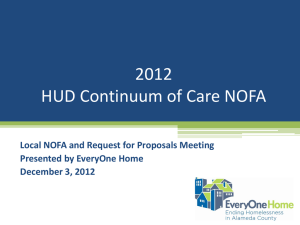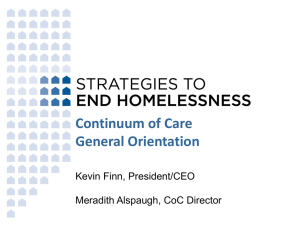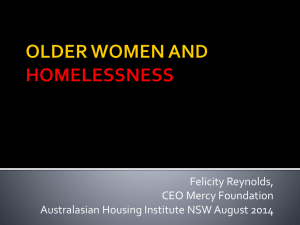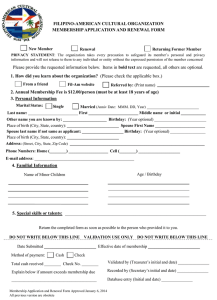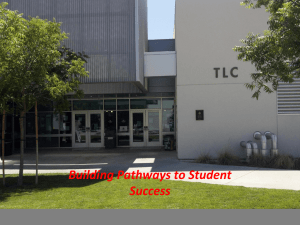of NOFA - Metro Denver Homeless Initiative
advertisement
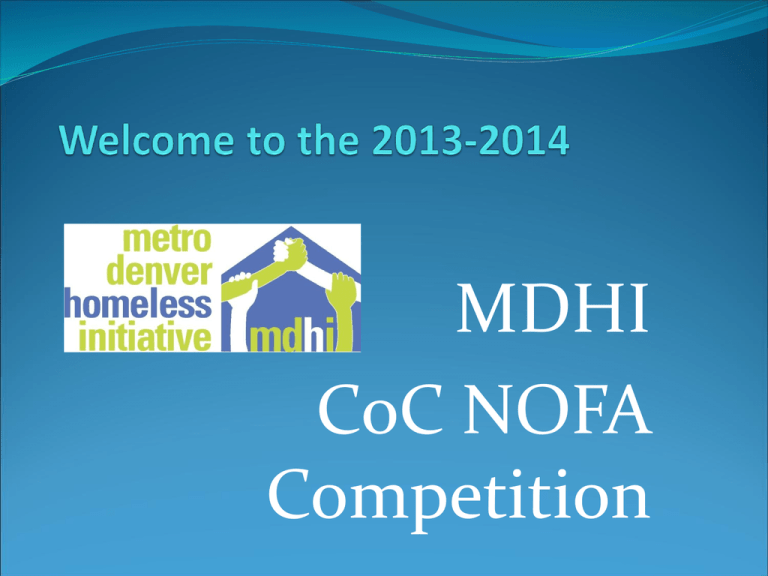
MDHI CoC NOFA Competition Presenters: Gary Sanford – Executive Director, Metro Denver Homeless Initiative Christine Groves – Grant Writer Nathan Davis - Program Manager, Mile High United Way Teri Marquantte – SWAN Enterprises & Consulting What’s New Two year application for CoC No new Permanent Housing Bonus Our annual renewal amount for current projects may be cut by at least 5% ($824,183) Pushing the targeting of the most in need Reallocation of renewal dollars to create more beds for CH individuals and homeless families with children What’s New New HUD Goals for benefits acquisitions 56%, & income other than employment – 54% Encourage healthcare acquisition through the Affordable Health Care Act Special focus on the Housing First Model Push to dedicate existing PSH units for the Chronically Homeless at turn over MDHI Renewal Application in WizeHive What’s Old but Changed Tiering again required with more direction regarding the order 1. PSH & RRH renewals 2. 3. 4. 5. Reallocated PSH Reallocated RRH Transitional Housing CoC Planning 6. Supportive Services previously reallocated into Coordinated Entry 7. Renewal HMIS 8. Supportive Services only grants (SSO) Rewarding good performance & achieving goals of ending homelessness Of the 156 points available in the Consolidated Application (150 points + 6 bonus points) 59 are dedicated to measuring and improving performance and outcomes Major goals re-emphasized in scoring: Reducing chronic homelessness Increasing housing stability Increasing income and benefits Increasing rapid housing These goals are tracked from project APR’s and then summarized in CoC Consolidated Application What will be used to rank current projects? APR’s MDHI Renewal Application HMIS Data Quality Reports Budget, match & leverage information Projects’ alignment with HUD and CoC goals & objectives Housing First approach and/or barriers to housing Willingness to dedicate turn over units to CH population APR’s Utilization rates % of households served that obtained housing and stabilized for at least 6 months Households moving from TH to PH Increased income and benefits during project participation and at exit MDHI Renewal Application Highlights: Types of households served in most recent APR cycle Subpopulations served in most recent APR Housing First Model Barriers to housing placement PSH = 80% of participants retain housing for 6 months or more MDHI Renewal Application Highlights: Transitional Housing households moved to PH at exit Increased Income & self-sufficiency through earned income &benefits acquisition HMIS information Diversity and outreach plans & practices Collaborative efforts in housing CH individuals & families MDHI Renewal Application Highlights: Community involvement by participants as well as volunteers Staff quality and how it mirrors your participants How your program works to move households on to selfsufficiency Identification and utilization of community services MDHI Renewal Application Highlights: Program Innovation and data usage from APR’s – best practices identified and used, APR info to evaluate program How you involve participants in goal setting, feedback on program, program decisions and your grievance plan HUD contract, project budget, Project leverage & match HUD’s Project Renewal Thresholds Read page 28 of NOFA Goals Timeliness standards for grant renewals including spending down funds Program participants achieving and maintaining independent living Program management New Projects Read page 23 – 28, Section C thru E.2.e.(3) of NOFA New projects from reallocation of existing projects only (no new money) Don’t know amount yet (if any) Letter of interest due by noon Dec. 10 Eligible activities spelled out in NOFA on page 12 Section B Reallocation Protocol (from HUD) HUD’s stated New Project Thresholds (From HUD CoC NOFA, page 26): 1. Type, scale & location of housing fits the needs of the program participants 2. Type, scale, location of the supportive services and the mode of transportation to those services fits the needs of program participants 3. Specific plan for ensuring program participants individually assisted to obtain mainstream benefits and employment 4. Program participants assisted to obtain and remain in permanent housing in a manner that fits their needs 5. Program participants assisted to both increase their income and live independently using mainstream housing & service programs 6. At least 75% of proposed program participants come from the street or other location not meant for hum habitation ES or safe havens 7. Whether amenities are accessible in the community CoC Consolidated Application Consolidated Application score dictates funding for next two years Each project application attached to CoC Consolidated Application affects the CoC’s score and funding Highest scoring CoC’s will go deepest into Tier Two Bonus Points : 7% admin costs, no SSO in Tier 1, accuracy of NOFA Continuum of Care Scoring (See HUD CoC NOFA, page 35) A. CoC Strategic Planning & Performance (69 pts): 1. Ending Chronic Homelessness: prioritizing the chronically homeless in ALL CoC funded permanent supportive housing – not just those units that are dedicated to that population and e prioritizing CH for placement as units become available through turnover 2.Housing Stability – ability of program participants to obtain and maintain housing 3.Jobs and Income Growth – extent to which program participants obtained or increase income/jobs 4.Mainstream Benefits – program participants increase of benefits 5.Rapid Re-Housing – how long it takes to place households in permanent housing 6.Opening Doors – plans on indentifying and ending barriers to housing Continuum of Care Scoring 8. Ending Family Homelessness– efforts to reduce number of homeless households with children including outreach plans 9. Addressing Needs of Victims of Domestic Violence – clear description of services and safe housing form funding within the CoC for this population 10. Ending Youth Homelessness – clear description of current efforts to address youth homelessness 11. Reaching Unsheltered Homeless – outreach and engagement efforts 12. Ending Veteran Homelessness – services and housing available for veterans from all funding sources Continuum of Care Scoring B. CoC Coordination of Housing and Services (28 points) 1.Preventing Homelessness – homeless prevention efforts including an analysis of barriers to housing, coordination with ESG, Consolidate Plans 2. Discharge Planning – Community plans for those coming from foster care, health care facilities, mental health facilities, correctional institutions 3.Consolidated Plan – listing of goals from Consolidated Plans that address homelessness 4.Emergency Solutions Grants – how CoC community determines allocation of ESG funds, coordination with ESG recipients and project evaluation 5.Coordination with Other Funding Sources:- demonstrate coordination with other federal, state, local, private entities serving homeless Continuum of Care Scoring 6. Affirmatively Furthering Fair Housing – identification and outreach to diverse homeless 7. Educational Assurances – for projects working with families with children 8. Preventing Involuntary Family Separations – CoC’s collaboration with shelter and housing provides to ensure homeless households with children und the age of 18 are not denied admission and are not separated 9. Affordable Health Care Act – CoC’s preparation with project recipients for the implementation of the Affordable Care Act and project participants access to health care 10. Resources for Service - how CoC is working with funding recipients to identify other sources of mainstream funding for supportive services to reduce the amount of CoC program funds used for supportive services Continuum of Care Scoring C. Recipient Performance (15 points) 1. Performance Monitoring – CoC monitors recipients performance on HUD-established goals 2. Increasing Performance – time in housing, increased income/benefits 3. Increasing Capacity – CoC’s assistance to underperforming recipients to increase capacity to meet requirements of Act, CoC Program interim rule and local priorities 4. Reducing Homeless Episodes – how CoC tracks time and episodes of homelessness as well as housing stability 5. Outreach – thoroughness of CoC plan for reaching all homeless subpopulations in 100% of CoC’s geographic area 6. Tracking & Reducing Returns to Homelessness – use of HMIS to monitor and explanation of plans to reduce number of additional returns to homelessness Continuum of Care Scoring D. CoC Housing, Services & Structure (13 points) 1. CoC Meetings – open, inclusive of homeless and/or formerly homeless 2. Complaints - any received and how handled 3. Inclusive Structures – considers full range of opinions from individuals or entities with knowledge of homelessness and open to proposals from entities not previously funded 4. Project Application Performance Metrics – review & ranking process 5. Housing Inventory Count Submissions Continuum of Care Scoring E. Leveraging (5 points) – looking for 100% participation by CoC funded recipients leveraging with 150% demonstrated leverage F. HMIS (11 points) - Governance, Privacy Plan, Security Plan, Data Quality Plan, funding, bed coverage, data quality, entry and exit dates, required reports G. Point-in-Time Count (9 points) – actual count and submission, change in PIT numbers, subpopulation data, methodology H. Bonus Points (up to 6 points) • 100% renewals administration at 7% or below • No SSO projects in Tier 1 • Accuracy of submission MDHI 2013 NOFA Time Line Date Tasks and Deliverables September 23, 2013 Grant Inventory Worksheet Due to HUD (completed) CoC Registration Due to HUD (completed) November 22, 2013 NOFA Release (completed) MDHI Distributes NOFA RFP (completed) MDHI Distributes request for letters of intent for new projects (completed) Mandatory meeting for NOFA applicants to review process (scoring tool, time frame, priorities) and address NOFA questions— Monday, December 9, 2013 from 9am to noon at Mile High United Way WizeHive site goes live September 10, 2013 Week of December 2, 2013 December 9, 2013 • Week of December 9, 2013 MDHI 2013 NOFA Time Line December 10, 2013 Applicants must send any feedback, recommended edits or changes to NOFA application to MDHI staff via email by 9am Letters of Intent for new projects due at noon on December 10, 2013 • NOFA applications for renewals are due to MDHI via WizeHIve by noon on December 23, 2013 • December 23, 2013 December 23, 2013 January 7, 2014 • NOFA applications for new projects are due to MDHI via email by noon on December 23, 2013 • Project Applicants (new and renewal projects) will be scheduled for presentations at NOFA Review Committee meeting—Morning of January 7, 2014 at Mile High United Way January 10, 2014 (tentative) Final ranking of renewal projects announced to Stakeholders Any and all appeals must be submitted to MDHI by noon on January 17, 2014 All projects due in e-snaps by noon on January 17, 2014 Committee and staff provide recommendations for full board consideration NOFA ranking presented to Board for review & approval Agencies who have appealed will receive in writing the decision prior to CoC NOFA application submission January 17, 2014 January 17, 2014 Week of January 20, 2014 Completed MDHI Consolidated Application published on MDHI website for community review and comment NOFA application submitted to HUD HUD deadline for submission—February 3, 2014 Week of January 27 Week of January 27 Resources: http://www.onecpd.info Access to training documents, instruction manuals, FAQ’s, and the help desk http://mdhi.org/ NOFA Announcement NOFA Timeline NOFA Renewal application NOFA Renewal Leverage chart NOFA Budget chart HMIS 2013 Data Quality report NOFA New Project Letter of Interest directions MDHI NOFA Appeals Process Effective Grant Writing Things to pay attention to and other important information Christine Groves Grant Writer/Consultant Using WizeHive How to use WizeHive Nathan Davis Project Manager Mile High United Way


